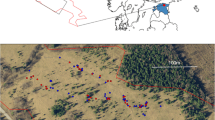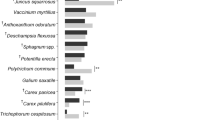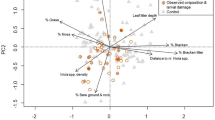Abstract
In invaded environments, formerly reliable cues might no longer be associated with adaptive outcomes and organisms can become trapped by their evolved responses. The invasion of Alliaria petiolata (garlic mustard) into the native habitat of Pieris virginiensis (West Virginia White) is one such example. Female butterflies oviposit on the invasive plant because it is related to their preferred native host plant Cardamine diphylla (toothwort), but larvae are unable to complete development. We have studied the impact of the A. petiolata invasion on P. virginiensis butterflies in the Southeastern USA by comparing oviposition preference and larval survival on both plants in North Carolina (NC) populations without A. petiolata and West Virginia (WV) populations where A. petiolata is present. Larval survival to the 3rd instar was equally low in both populations when raised on A. petiolata. Mean oviposition preference on the two plants also did not differ between populations. However, we found a seasonal effect on preference between early and late season flights within WV populations. Late season females laid 99% of total eggs on A. petiolata while early season females utilized both host plants. Late season females were also less likely to lay eggs than early season females. This change in preference toward A. petiolata could be driven by the early senescence of C. diphylla and suggests a seasonal component to the impact of A. petiolata. Therefore, the already short flight season of P. virginiensis could become further constrained in invaded populations.



Similar content being viewed by others
References
Ali JG, Agrawal AA (2012) Specialist versus generalist insect herbivores and plant defense. Trends Plant Sci 17:293–302
Anderson R (1996) Aspects of the ecology of an invasive plant, garlic mustard (Alliaria petiolata), in central Illinois. Restor Ecol 4:181–191
Barto EK, Powell JR, Cipollini D (2010) How novel are the chemical weapons of garlic mustard in North American forest understories? Biol Invasions 12:3465–3471
Bates D, Mächler M, Bolker B, Walker S (2015) Fitting linear mixed-effects models using lme4. J Stat Softw. doi:10.18637/jss.v067.i01
Bowden SR (1971) American white butterflies (Pieridae) and English foodplants. J Lepidopterists Soc 25:6–12
Burke DJ (2008) Effects of Alliaria petiolata (garlic mustard; Brassicaceae) on mycorrhizal colonization and community structure in three herbaceous plants in a mixed deciduous forest. Am J Bot 95:1416–1425
Calhoun JV, Iftner DC (1988) An additional natural hostplant of Pieris virginiensis (W.H. Edwards) (Pieridae) in Ohio. J Res Lepidoptera 27:141–142
Callaway RM, Cipollini D, Barto K, Barto K, Thelen GC, Hallett SG, Prati D, Stinson K, Klironomos J (2008) Novel weapons: invasive plant suppresses fungal mutualists in America but not in its native Europe. Ecology 89:1043–1055
Cappuccino N, Kareiva P (1985) Coping with a capricious environment: a population study of a rare Pierid butterfly. Ecology 66:152
Cavers PB, Heagy MI, Kokron RF (1979) The biology of Canadian weeds.: 35. Alliaria petiolata (M. Bieb.) Cavara and Grande. Can J Plant Sci 59:217–229
Chew FS (1980) Foodplant preferences of Pieris caterpillars (Lepidoptera). Oecologia 46:347–353
Cornell HV, Hawkins BA (2003) Herbivore responses to plant secondary compounds: a test of phytochemical coevolution theory. Am Nat 161:507–522
Courant AV, Holbrook AE, Van der Reijden ED, Chew FS (1994) Native Pierine butterfly (Pieridae) adapting to naturalized crucifer? J Lepidopterists Soc 48:168–170
Davis SL, Cipollini D (2014a) Do mothers always know best? Oviposition mistakes and resulting larval failure of Pieris virginiensis on Alliaria petiolata, a novel, toxic host. Biol Invasions 16:1941–1950
Davis SL, Cipollini D (2014b) How environmental conditions and changing landscapes influence the survival and reproduction of a rare butterfly, Pieris virginiensis (Pieridae). J Lepidopterists Soc 68:61–65
Davis SL, Cipollini D (2016) Range, genetic diversity and future of the threatened butterfly, Pieris virginiensis. Insect Conserv Divers 9:506–516
Davis SL, Frisch T, Bjarnholt N, Cipollini D (2015) How does garlic mustard lure and kill the West Virginia white butterfly? J Chem Ecol 41:948–955
Doak P, Kareiva P, Kingsolver J (2006) Fitness consequences of choosy oviposition for a time-limited butterfly. Ecology 87:395–408
Finnell AS, Lehn CA (2007) West Virginia White butterfly (Pieris virginiensis) conservation plan. Version 1.0, pp 1–14. http://leapbio.org/content/4-resources/0-west-virginia-white-butterfly/wvw_conservation_plan_20070326.pdf. Accessed 1 May 2016
Frisch T, Agerbirk N, Davis S et al (2014) Glucosinolate-related glucosides in Alliaria petiolata: sources of variation in the plant and different metabolism in an adapted specialist herbivore, Pieris rapae. J Chem Ecol 40:1063–1079
Gordon DR (1998) Effects of invasive, non-indigenous plant species on ecosystem processes: lessons from Florida. Ecol Appl 8:975–989
Huang XP, Renwick JAA, Chew FS (1995) Oviposition stimulants and deterrents control acceptance of Alliaria petiolata by Pieris rapae and P. napi oleracea. Chemoecology 5(6):79–87
Huebner CD (2003) Vulnerability of oak-dominated forests in West Virginia to invasive exotic plants: temporal and spatial patterns of nine exotic species using herbarium records and land classification data. Castanea 68:1–14
Keeler MS, Chew FS (2008) Escaping an evolutionary trap: preference and performance of a native insect on an exotic invasive host. Oecologia 156:559–568
Mather B (1964) The southern limits of the range of Pieris napi and Pieris virginiensis. J Res Lepid 3:45–48
Meekins JF, McCarthy BC (1999) Competitive ability of Alliaria petiolata (Garlic Mustard, Brassicaceae), an invasive, nonindigenous forest herb. Int J Plant Sci 160:743–752
Pimentel D, Zuniga R, Morrison D (2005) Update on the environmental and economic costs associated with alien-invasive species in the United States. Ecol Econ 52:273–288
Porter A (1994) Implications of introduced garlic mustard (Alliaria petiolata) in the habitat of Pieris virginiensis (Pieridae). J Lepidopterists Soc 48:171–172
Prati D, Bossdorf O (2004) Allelopathic inhibition of germination by Alliaria petiolata (Brassicaceae). Am J Bot 91:285–288
R Core Team (2016) R: a language and environment for statistical computing. R Foundation for Statistical Computing, Vienna. https://www.R-project.org
Renwick JAA (1989) Chemical ecology of oviposition in phytophagous insects. Experientia 45:223–228
Roberts KJ, Anderson RC (2001) Effect of garlic mustard [Alliaria petiolata (Beib. Cavara & Grande)] extracts on plants and arbuscular mycorrhizal (AM) fungi. Am Midl Nat 146:146–152
Rodgers VL, Stinson KA, Finzi AC (2008) Ready or not, garlic mustard is moving in: Alliaria petiolata as a member of eastern North American forests. Bioscience 58:426–436
Schoonhoven LM, van Loon JJA, Dicke M (2005) Insect–plant biology, 2nd edn. Oxford University Press, Oxford
Shapiro AM (1971) Occurence of a latent polyphenism in Pieris virginiensis (Lepidoptera: Pieridae). Entomol News 82:13–16
Shuey JA, Peacock JW (1989) Host plant exploitation by an oligophagous population of Pieris virginiensis (Lepidoptera: Pieridae). Am Midl Nat 122:255
van der Putten WH, de Ruiter PC, Martijn Bezemer T et al (2004) Trophic interactions in a changing world. Basic Appl Ecol 5:487–494
Vaughn SF, Berhow MA (1999) Allelochemicals isolated from tissues of the invasive weed garlic mustard (Alliaria petiolata). J Chem Ecol 25:2495–2504
Welk E, Schubert K, Hoffman MH (2002) Present and potential distribution of invasive garlic mustard (Alliaria petiolata) in North America. Divers Distrib 8:219–233
Wolfe BE, Rodgers VL, Stinson KA, Pringle A (2008) The invasive plant Alliaria petiolata (garlic mustard) inhibits ectomycorrhizal fungi in its introduced range. J Ecol 96:777–783
Acknowledgements
We would like to thank Nantahala National Forest and Monongahela National Forest for access to collection sites. Highlands Biological Station for access to lab space and 2 years of support from their Grant-In-Aid program. Harry LeGrand, Henry Wilbur, and Catherine Johnson for help identifying field sites. Kati Moore and Elizabeth Anglin for help with field experiments, and Jessica Higgins and Heidi MacLean for help with lab experiments. Rachel Steward and two anonymous reviewers provided valuable comments on previous versions of the manuscript. This research was funded by the National Science Foundation Grant IOS-1120500 to JGK.
Author information
Authors and Affiliations
Corresponding author
Rights and permissions
About this article
Cite this article
Augustine, K.E., Kingsolver, J.G. Biogeography and phenology of oviposition preference and larval performance of Pieris virginiensis butterflies on native and invasive host plants. Biol Invasions 20, 413–422 (2018). https://doi.org/10.1007/s10530-017-1543-9
Received:
Accepted:
Published:
Issue Date:
DOI: https://doi.org/10.1007/s10530-017-1543-9




